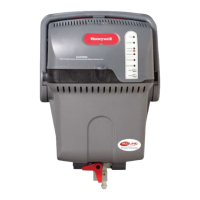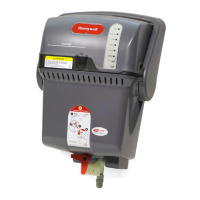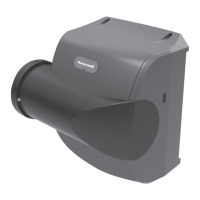7
How does fresh air ventilation affect indoor humidity?
Outdoor conditions during the humidification season are drier than indoor conditions.
1. Ventilation occurs naturally via the ‘breathing’ that occurs within the home. This infiltration/exfiltration has become more restrictive as
new home construction has followed tighter building practices for improved energy efficiency.
2. Ventilation also occurs mechanically, through intake and exhaust ventilation devices, such as heat and energy recovery cores, fireplace
flues or open windows. Ventilation can have a negative affect on the humidity level achievable and the overall run time of the humidifier.
Understanding natural and mechanical ventilation rates is important when choosing the best humidifier size for the home and in setting
expectations with the homeowner upon installation.
How does warmer air affect humidity?
Relative humidity is the ratio between the amount of moisture in the air and the amount of moisture the air is capable of holding at a given
temperature. A higher air temperature with a fixed amount of vaporized water will have a lower Relative Humidity than that same amount of
vaporized water in a lower air temperature because warm air can hold more moisture than cold air.
This basic science is important in understanding how to size the humidifier, especially when considering intake ventilation in the form of
natural building 'breathing' or mechanical ventilation. Warmer air entering the space can actually decrease the %RH ratio. It may be the
same amount of vaporized water, but because air temperature increased, the %RH decreased. It is better to err on the side of over sizing
the humidifier when dealing with higher indoor air temperatures.
What is the issue with undersizing the humidifier to the space?
Undersizing the humidifier will not only reduce the potential to meet the homeowner's desired humidity set point, it may also lead to
extensive system fan run time or higher operating costs as it tries to deliver to the control’s setting. While oversizing the humidifier may lead
to higher amp draw, the system run time will be less, which in some situations may be less expensive at the bottom line. Refer to Chart 3
and 4 above for average run times and operating costs.
SIZING
Summary
The first priority for most homeowners with centrally ducted humidification is comfort, followed closely by operating cost and run time.
The best solution for your customer is a humidification system that will achieve their desired humidity setting, while minimizing the run
time and operating costs. As part of the selling process, it may be necessary to educate the homeowner on what ideal humidity is, and
what is realistic for the humidifier they are willing to purchase. Also take into consideration external variables within the home which may
negatively impact the humidification capacities possible. The purpose of this paper is to provide guidance on evaluating homes and
choosing the best TrueSTEAM model for the home.
Additional information can be found online at www.forwardthinking.honeywell.com/truesteam

